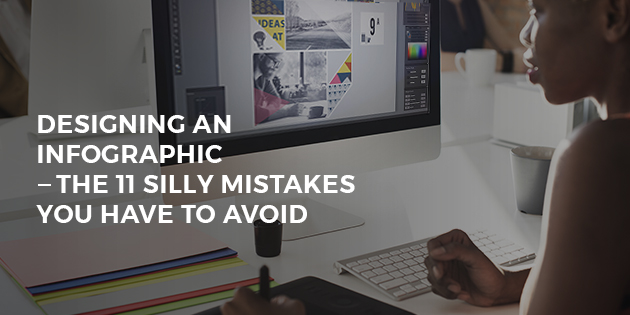The shareable nature of infographics makes them a great addition to your content marketing strategy. You just have to make sure you avoid these key mistakes.
Have you considered using infographics to expand the reach of your content?
You should!
Infographics are among the most shareable content types out there. Image-based and with minimal text, they’re ideal for a quick skim. They also contain pointed information that’s instantly quotable and shareable.
The stats bear this out too.
According to Progressive Content, which is a marketing firm, infographics are 30 times more likely to get read than a pure text article.
That is…assuming you design the infographic properly.
A badly-designed infographic destroys any potential it might have as an audience builder or lead generator.
We’re going to look at some of the key mistakes that designers make with infographics. But first, let’s dig into what they are.
What Is an Infographic?
The core idea behind infographics is that they deliver information in a way that’s easy for your audience to digest.
To do that, they use a combination of attractive imagery and short lines of text. Typically, designers use them to break complex subjects down into smaller parts. The reader can then easily understand the subject, which makes them more likely to read all of the content.
The key to a great infographic is that the information presented flows in a logical manner. Again, this contributes to the ease with which the reader can digest the information. A lack of logic means the reader struggles…
But we’ll get to that in a moment.
There are also several categories of infographics. These include the following:
- Informational infographics that tend to share key statistics and data about a subject.
- Chart-based infographics, which you may use to simplify large data sets.
- Timeline infographics, which chart events in a logical order.
- How-to/Process infographics, which offer step-by-step instructions.
- Comparison infographics, which may show the differences between two similar items. These may also highlight the pros and cons of a particular thing or service.
As long as the information’s scannable and presented in an attractive and visual way, it’s usually classed as an infographic.
It sounds fairly simple, right?
That’s not the case. In fact, there are many mistakes that you might make when designing an infographic…
Mistake #1 – Disorganised Data
We touched on this above.
If your infographic doesn’t have a logical flow to it, readers will quickly disengage. This mistake is most commonly seen in how-to infographics. The designer will outline the steps but may mess up the order. Or, the infographic’s design will appear cluttered and disorganised, which makes it difficult to figure out the order of the steps.
Make sure you read the content before publishing your infographic. If you find yourself struggling to work your way through the data, you can bet your audience will too.
Mistake #2 – Poor Branding
You’re aiming to market your business to a wider audience using your infographic.
That means you need to find ways to associate your brand with the data that you’re sharing. Adding your logo or company name will help, as long as you do it subtly.
Perhaps more effective is to use an appropriate colour scheme.
If the colours used in the design don’t relate to your brand, there’s less chance that the reader will make the association. This makes the infographic less effective as a marketing tool.

Mistake #3 – You Don’t Include References
Most infographics include statistics and other data.
The problem comes if you fail to provide references for all of that information. You’re assuming that the reader will just trust you at your word.
Many won’t.
Instead, they’ll see an unsourced infographic and immediately assume that they can’t trust the information in it.
This is an easily-fixable situation. Just make sure there’s a list of references at the bottom of the infographic. This also makes it easier for the reader to check the data for themselves, thus making the infographic more user-friendly.
Mistake #4 – Weak Data Visualisation
This is a particular issue for chart-based infographics.
Your choice of charts may lead to accusations of misrepresenting the data that you’re presenting. That’s why it’s crucial that you choose the right chart for displaying the data.
But that’s not the only problem.
You’re also aiming to make this data as scannable as possible. That means it’s possible that you’ll choose the right chart and still run into this issue. The small things, such as labelling, colour-coding, and data ordering, all have an impact.
Even something as simple as a pie chart not adding up to 100% can pull the authority right out of the infographic.
Always double-check any visual elements that you use to represent data. It may also be worth asking an independent party to take a look. If they raise any points of confusion, you may need to rethink your data visualisation.
Mistake #5 – Trying to Tackle Too Many Subjects
This is a common mistake because the format of an infographic almost encourages it. You’re trying to boil complex information down to its most basic and important points.
That usually means you’re going to have to cut some information out to maintain the flow of the document.
Failure to do that can lead to you designing an infographic that’s either too long or too cluttered.
The solution is to plan things out beforehand. Figure out exactly what point you want to make and only use the content chunks that support that point.
Anything that needlessly extends the infographic must go straight to the chopping block.

Mistake #6 – A Poor Balance Between Text and Visuals
A great infographic uses text and visuals to create a cohesive whole. Each element complements the other to make the content as scannable as possible.
A lack of balance between these elements can cause problems.
Too much text turns the infographic into a mini-article. This eliminates the point of creating the infographic in the first place. You’re making it harder to scan, which means it’s easier for viewers to breeze past important information.
However, relying too heavily on visuals also causes problems. This suggests that you don’t really have much of a point to make so you’re hoping to distract the viewer with pictures.
There are two ways to redress this balance.
If you find yourself taking a long time to read the text, this suggests there’s too much of it. Start making cuts and think about other visual elements that you could add.
However, if you come away from the infographic feeling as though you haven’t learned anything, you may have too many visuals. A little more text can help with the balance in this situation.
Mistake #7 – Using a Weak Template
The popularity of infographics has led to people designing standard templates for them.
These are ideal for those who aren’t natural designers. They can help you to put the content together quickly and the templates tend to have a logical flow.
However, it’s crucial that you make some changes to the template. This comes back to the branding issue that we mentioned earlier. If the design looks too familiar, it may be obvious that you’re using a template.
So, consider a template as a great way to get started on designing an infographic. However, you’ll still need to make alterations and bring in some unique elements to make it effective.
Mistake #8 – Talking About Yourself
People don’t look to infographics to get sales pitches. The content format is established now and people know that an infographic should provide interesting data.
If you’re solely talking about your product, you’re making a key mistake.
The reader will quickly decide the infographic is nothing but a visual sales pitch. This usually leads to them disengaging from the content. Plus, it may lead to you damaging the trust that that reader had in you.
An infographic can be a useful selling tool and it’s always a good idea to add a CTA in a place where it makes sense. But always remember that people engage with this content type because they want to learn something new.
They’re more interested in that than finding out more about you.
Mistake #9 – A Lack of Hierarchy
This mistake comes back to structuring the data that you share in your infographic.
There has to be a clear start point for the reader. And from there, you need to have a clear flow between one content chunk and the next.
A sloppy infographic will see the designer just dump chunks of text onto a set of graphics. Don’t make that mistake because it causes people to disengage from the document.
Mistake #10 – Not Following Conventions
Yes, you want your infographic to look as unique as possible. However, there are certain design conventions that you have to follow, particularly when using charts.
For example, you may have a chart with x and y axes. Flipping those axes or having them read back to front may seem like good ways to differentiate your visuals. But all you’re really doing is making the chart harder to read.
You haven’t followed the conventions that the reader already knows and understands. Again, this can lead to them disengaging from the infographic.
Mistake #11 – You Have a Boring Headline
Remember that an infographic is still a piece of content. That means you’ve got to find a way to pull the reader in.
Much like with articles, your headline is key here. If it’s too boring, the reader will assume that the rest of the information you share isn’t worth their time.
A good headline contains at least one power word. This is a strong word that makes the reader feel an emotion. If yours is too dry, you’re likely going to alienate a portion of your potential audience.
You Don’t Have to do it Alone
As you can see, there’s a lot that can go wrong with something that seems so simple. A great infographic is so much more than the text and visuals that you use.
It’s about using those elements to create something that’s cohesive, logical, and interesting.
That’s where Automation Agency comes in.
Our team can create stunning infographics that get your point across and match your branding. Just send a task to our Concierge Service to get started.
But what if you’re not a member yet?
Use our Right Fit Chatbot to find out about what we do and whether we’re a good fit for your business. If you think that we can work together, we’re happy to schedule a chat with you.


